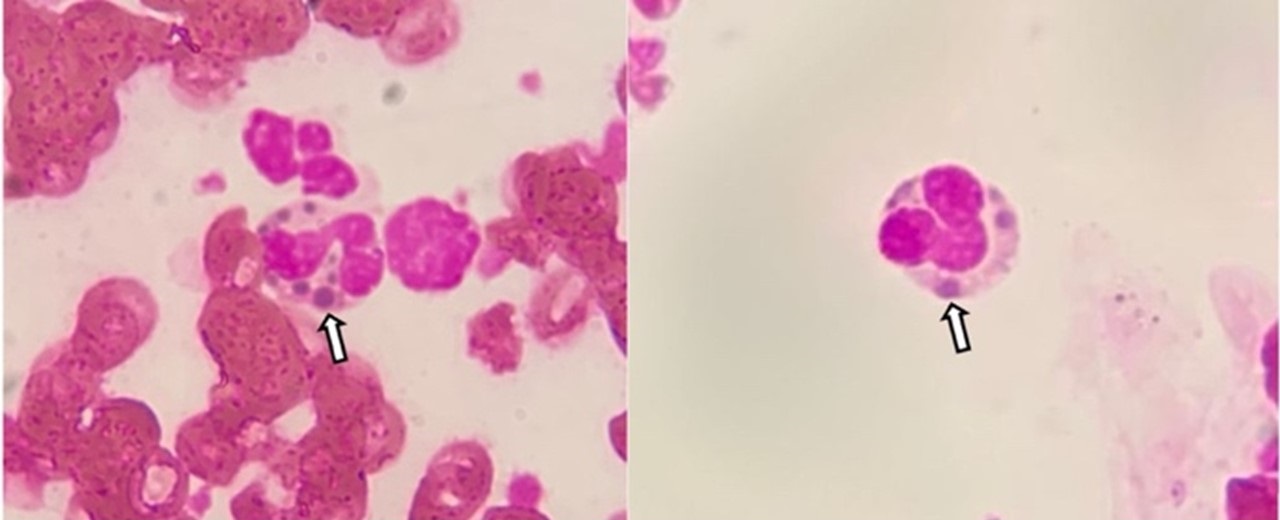Diagnosa dan penanganan Ehrlichiosis pada seekor anjing Pug
Abstrak
Infestasi caplak pada anjing selain merusak kulit, menimbulkan reaksi inflamasi, dan anemia, caplak juga merupakan vektor parasit darah seperti Ehrlichia spp. sebagai Ehrlihciosis.Tulisan ini melaporkan kasus seekor anjing Pug betina berumur 5 tahun dengan kondisi tubuh dipenuhi caplak. Hasil pemeriksaan klinis ditemukan infestasi caplak pada wajah, telinga, punggung, abdomen, kaki dan interdigital. Pemeriksaan penunjang yang dilakukan yaitu pemeriksaan complete blood count (CBC), buffy coat smear dan test kit. Hasil pemeriksaan CBC menunjukkan anjing kasus mengalami leukositosis, neutrofilia, anemia mikrositik hipokromik dan trombositopenia. Pemeriksaan buffy coat smear menunjukkan adanya morula Ehrlichia dalam sitoplasma monosit anjing dan hasil test kit positif mengandung antibodi Ehrlichia sehingga anjing didiagnosis menderita Ehrlichiosis. Penanganan dilakukan dengan pemberian antibiotika Doxycycline, Intervetta Dr. Choice Ferro-B dan Fu Fang Ejiao Jiang, PO selama 21 hari. Pasca penanganan, parameter hematologi berupa leukosit, neutrofil, eritrosit dan trombosit sudah kembali dalam rentang normal.
Unduh
Referensi
Aziz MU, Hussain S, Song B, Ghauri HN, Zeb J, Sparagano OA. 2022. Ehrlichiosis in dogs: A comprehensive review about the pathogen and its vectors with emphasis on south and east Asian countries. Veterinary Sciences. 10(1):21. https://doi.org/10.3390/vetsci10010021 | PMid:36669021 PMCid:PMC9863373
Chandran D, Edana GG, Varghese S, Kumar AS. 2021. A case study of assessment of Haemato-Biochemical profile, clinical diagnosis and therapeutic management of Canine Monocytic Ehrlichiosis (Tropical Canine Pancytopenia) in a male Doberman dog. Internasional Journal of Scientific Research in Science and Technology. 8(4):426-434. https://doi.org/10.32628/IJSRST218467
De Waal T, Lawlor A, Zintl A, Cowley B, Bagha A. 2020. A survey of ticks infesting dogs and cats in Ireland. Animals. 10(8):1404. https://doi.org/10.3390/ani10081404 | PMid:32806603 PMCid:PMC7460173
Kaewmongkol S, Suwan E, Sirinarumitr T, Jittapalapong S, Fenwick SG, Kaewmongkol G. 2020. Detection of specific IgM and IgG antibodies in acute canine monocytic ehrlichiosis that recognize recombinant gp36 antigens. Heliyon. 6(7):e04409. https://doi.org/10.1016/j.heliyon.2020.e04409 | PMid:32685730 PMCid:PMC7358732
Monsalve S, Gallego V, Molina VM, Rodas J. 2017. Pharmacokinetics and adverse effects of doxycycline in the treatment of Ehrlichiosis: theoretical foundations for clinical trials in ca-nines. Revista MVZ Córdoba. 22(2017):6062-6074. https://doi.org/10.21897/rmvz.1076
Procajło A, Skupień E, Bladowski M, Lew S. 2011. Monocytic ehrlichiosis in dogs. Polish Journal of Veterinary Sciences. 14(3):515-520. https://doi.org/10.2478/v10181-011-0077-9 | PMid:21957751
Rabiulfa P, Sewoyo PS, Purwitasari MS, Soma IG, Erawan IGMK. 2023. Traditional chinese herbal medicine Fufang E'Jiao Jiang as supportive treatment in Anaplasmosis management of a British Shorthair cat. International Journal of Veterinary and Animal Research. 6(2):72-76.
Ramakant, Kumar R, Verma HC, Diwakar RP. 2020. Canine ehrlichiosis: A review. Journal of Entomology and Zoology Study. 8(2):1849-1852.
Saito TB, Walker DH. 2016. Ehrlichioses: an important one health opportunity. Veterinary Sciences. 3(3):20. https://doi.org/10.3390/vetsci3030020 | PMid:29056728 PMCid:PMC5606584
Sharma DK, Gupta VK, Bansal S, Joshi V, Mandal RSK, Singh M, Bhanuprakash AG. 2015. Therapeutic efficacy of doxycycline with whole blood transfusion in management of thrombocytopenic ehrlichiosis in canines. International Journal of Advanced Research. 3(7):353-357.
Shrestha A, Karmacharya R. 2016. Ehrlichiosis in a dog: A case study. Internasional Journal of Veterinary Sciences and Animal Husbandary. 1(5):20-23.
Suartha IN, Pradnyantari AASI, Erawan IGMK, Mahardika IGNK. 2023. Clinical Observations, Hematological Profile, Serological Testing, and Molecular Detection of Ehrlichia canis in Veterinary Clinics in Bali, Indonesia. International Journal of Veterinary Science. 12(1):70-75.

Copyright (c) 2024 CC BY-SA

This work is licensed under a Creative Commons Attribution-ShareAlike 4.0 International License.
Authors who publish with this journal agree to the following terms:
1. Authors retain copyright and grant the journal right of first publication with the work simultaneously licensed under a Creative Commons Attribution License that allows others to share the work with an acknowledgement of the work's authorship and initial publication in this journal.
2. Authors are able to enter into separate, additional contractual arrangements for the non-exclusive distribution of the journal's published version of the work (e.g., post it to an institutional repository or publish it in a book), with an acknowledgement of its initial publication in this journal.
3. Authors are permitted and encouraged to post their work online (e.g., in institutional repositories or on their website) prior to and during the submission process, as it can lead to productive exchanges, as well as earlier and greater citation of published work (See The Effect of Open Access).











